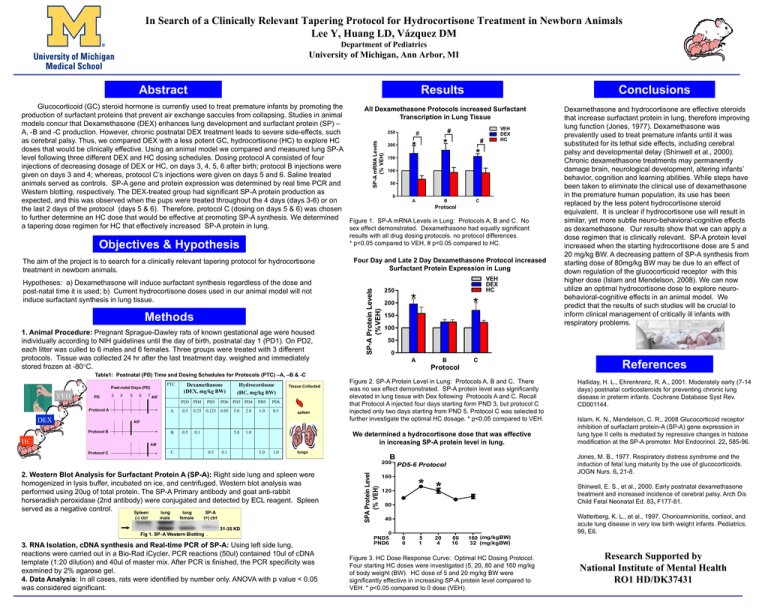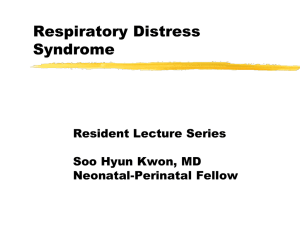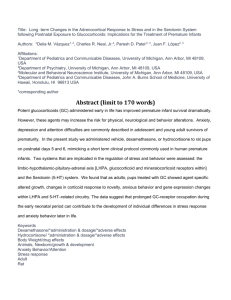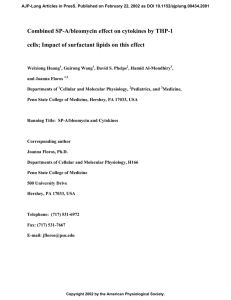
In Search of a Clinically Relevant Tapering Protocol for Hydrocortisone Treatment in Newborn Animals
Lee Y, Huang LD, Vázquez DM
Department of Pediatrics
University of Michigan, Ann Arbor, MI
Abstract
Results
Conclusions
SP-A mRNA Levels
(% VEH)
Glucocorticoid (GC) steroid hormone is currently used to treat premature infants by promoting the
All Dexamethasone Protocols increased Surfactant
production of surfactant proteins that prevent air exchange saccules from collapsing. Studies in animal
Transcription in Lung Tissue
models concur that Dexamethasone (DEX) enhances lung development and surfactant protein (SP) –
VEH
#
250
A, -B and -C production. However, chronic postnatal DEX treatment leads to severe side-effects, such
#
DEX
HC
as cerebral palsy. Thus, we compared DEX with a less potent GC, hydrocortisone (HC) to explore HC
#
200
*
*
doses that would be clinically effective. Using an animal model we compared and measured lung SP-A
*
150
level following three different DEX and HC dosing schedules. Dosing protocol A consisted of four
injections of decreasing dosage of DEX or HC, on days 3, 4, 5, 6 after birth; protocol B injections were
100
given on days 3 and 4; whereas, protocol C’s injections were given on days 5 and 6. Saline treated
50
animals served as controls. SP-A gene and protein expression was determined by real time PCR and
Western blotting, respectively. The DEX-treated group had significant SP-A protein production as
0
A
B
C
expected, and this was observed when the pups were treated throughout the 4 days (days 3-6) or on
Protocol
the last 2 days of the protocol (days 5 & 6). Therefore, protocol C (dosing on days 5 & 6) was chosen
to further determine an HC dose that would be effective at promoting SP-A synthesis. We determined
Figure 1. SP-A mRNA Levels in Lung: Protocols A, B and C. No
a tapering dose regimen for HC that effectively increased SP-A protein in lung.
sex effect demonstrated. Dexamethasone had equally significant
results with all drug dosing protocols. no protocol differences.
* p<0.05 compared to VEH, # p<0.05 compared to HC.
The aim of the project is to search for a clinically relevant tapering protocol for hydrocortisone
treatment in newborn animals.
Hypotheses: a) Dexamethasone will induce surfactant synthesis regardless of the dose and
post-natal time it is used; b) Current hydrocortisone doses used in our animal model will not
induce surfactant synthesis in lung tissue.
Methods
1. Animal Procedure: Pregnant Sprague-Dawley rats of known gestational age were housed
individually according to NIH guidelines until the day of birth, postnatal day 1 (PD1). On PD2,
each litter was culled to 6 males and 6 females. Three groups were treated with 3 different
protocols. Tissue was collected 24 hr after the last treatment day. weighed and immediately
stored frozen at -80C.
Four Day and Late 2 Day Dexamethasone Protocol increased
Surfactant Protein Expression in Lung
SP-A Protein Levels
(%VEH)
Objectives & Hypothesis
VEH
DEX
HC
250
*
200
*
150
100
Dexamethasone and hydrocortisone are effective steroids
that increase surfactant protein in lung, therefore improving
lung function (Jones, 1977). Dexamethasone was
prevalently used to treat premature infants until it was
substituted for its lethal side effects, including cerebral
palsy and developmental delay (Shinwell et al., 2000).
Chronic dexamethasone treatments may permanently
damage brain, neurological development, altering infants’
behavior, cognition and learning abilities. While steps have
been taken to eliminate the clinical use of dexamethasone
in the premature human population, its use has been
replaced by the less potent hydrocortisone steroid
equivalent. It is unclear if hydrocortisone use will result in
similar, yet more subtle neuro-behavioral-cognitive effects
as dexamethasone. Our results show that we can apply a
dose regimen that is clinically relevant. SP-A protein level
increased when the starting hydrocortisone dose are 5 and
20 mg/kg BW. A decreasing pattern of SP-A synthesis from
starting dose of 80mg/kg BW may be due to an effect of
down regulation of the glucocorticoid receptor with this
higher dose (Islam and Mendelson, 2008). We can now
utilize an optimal hydrocortisone dose to explore neurobehavioral-cognitive effects in an animal model. We
predict that the results of such studies will be crucial to
inform clinical management of critically ill infants with
respiratory problems.
50
0
A
B
C
Protocol
References
Table1: Postnatal (PD) Time and Dosing Schedules for Protocols (PTC) –A, –B & -C
PTC
Post-natal Days (PD)
VEH
PD
3
4
5
6
7 kill
Protocol A
DEX
A
Dexamethasone
(DEX, mg/kg BW)
Hydrocortisone
(HC, mg/kg BW)
PD3 PD4
PD5
PD6 PD3 PD4
PD5
PD6
0.5
0.125
0.05
1.0
0.5
0.25
5.0
2.0
Tissue Collected
spleen
kill
Protocol B
B
HC
0.5
0.1
5.0
1.0
We determined a hydrocortisone dose that was effective
in increasing SP-A protein level in lung.
kill
C
Protocol C
0.5
0.1
Figure 2. SP-A Protein Level in Lung: Protocols A, B and C. There
was no sex effect demonstrated. SP-A protein level was significantly
elevated in lung tissue with Dex following Protocols A and C. Recall
that Protocol A injected four days starting form PND 3, but protocol C
injected only two days starting from PND 5. Protocol C was selected to
further investigate the optimal HC dosage. * p<0.05 compared to VEH.
5.0
1.0
B
female
(+) ctrl
31-35 KD
Fig 1. SP -A Western Blotting
.
3. RNA Isolation, cDNA synthesis and Real-time PCR of SP-A: Using left side lung,
reactions were carried out in a Bio-Rad iCycler. PCR reactions (50ul) contained 10ul of cDNA
template (1:20 dilution) and 40ul of master mix. After PCR is finished, the PCR specificity was
examined by 2% agarose gel.
4. Data Analysis: In all cases, rats were identified by number only. ANOVA with p value < 0.05
was considered significant.
SPA Protein Level
(% VEH)
2. Western Blot Analysis for Surfactant Protein A (SP-A): Right side lung and spleen were
homogenized in lysis buffer, incubated on ice, and centrifuged. Western blot analysis was
performed using 20ug of total protein. The SP-A Primary antibody and goat anti-rabbit
horseradish peroxidase (2nd antibody) were conjugated and detected by ECL reagent. Spleen
served as a negative control.
Spleen
lung
lung
SP-A
male
Islam, K. N., Mendelson, C. R., 2008 Glucocorticoid receptor
inhibition of surfactant protein-A (SP-A) gene expression in
lung type II cells is mediated by repressive changes in histone
modification at the SP-A promoter. Mol Endocrinol. 22, 585-96.
lungs
200
(-) ctrl
Halliday, H. L., Ehrenkranz, R. A., 2001. Moderately early (7-14
days) postnatal corticosteroids for preventing chronic lung
disease in preterm infants. Cochrane Database Syst Rev.
CD001144.
Jones, M. B., 1977. Respiratory distress syndrome and the
induction of fetal lung maturity by the use of glucocorticoids.
JOGN Nurs. 6, 21-8.
PD5-6 Protocol
160
* *
120
Shinwell, E. S., et al., 2000. Early postnatal dexamethasone
treatment and increased incidence of cerebral palsy. Arch Dis
Child Fetal Neonatal Ed. 83, F177-81.
80
Watterberg, K. L., et al., 1997. Chorioamnionitis, cortisol, and
acute lung disease in very low birth weight infants. Pediatrics.
99, E6.
40
0
PND5
PND6
0
0
5
1
20
4
80
16
160 (mg/kgBW)
32 (mg/kgBW)
Figure 3. HC Dose Response Curve: Optimal HC Dosing Protocol.
Four starting HC doses were investigated (5, 20, 80 and 160 mg/kg
of body weight (BW). HC dose of 5 and 20 mg/kg BW were
significantly effective in increasing SP-A protein level compared to
VEH. * p<0.05 compared to 0 dose (VEH).
Research Supported by
National Institute of Mental Health
RO1 HD/DK37431












